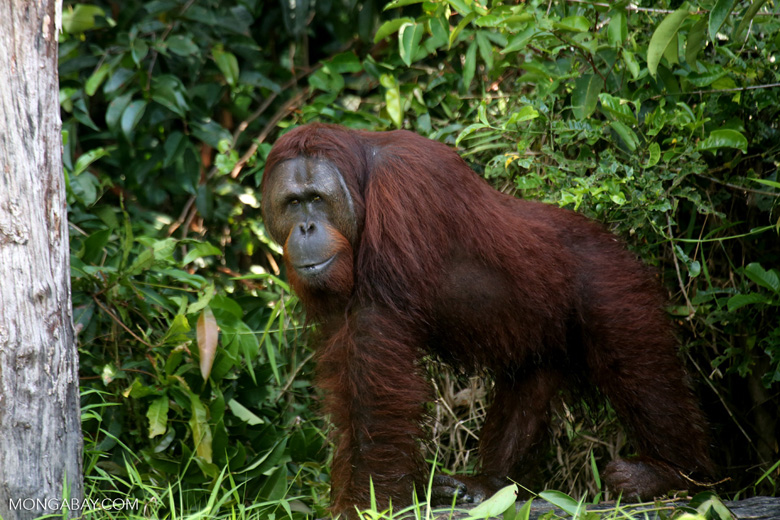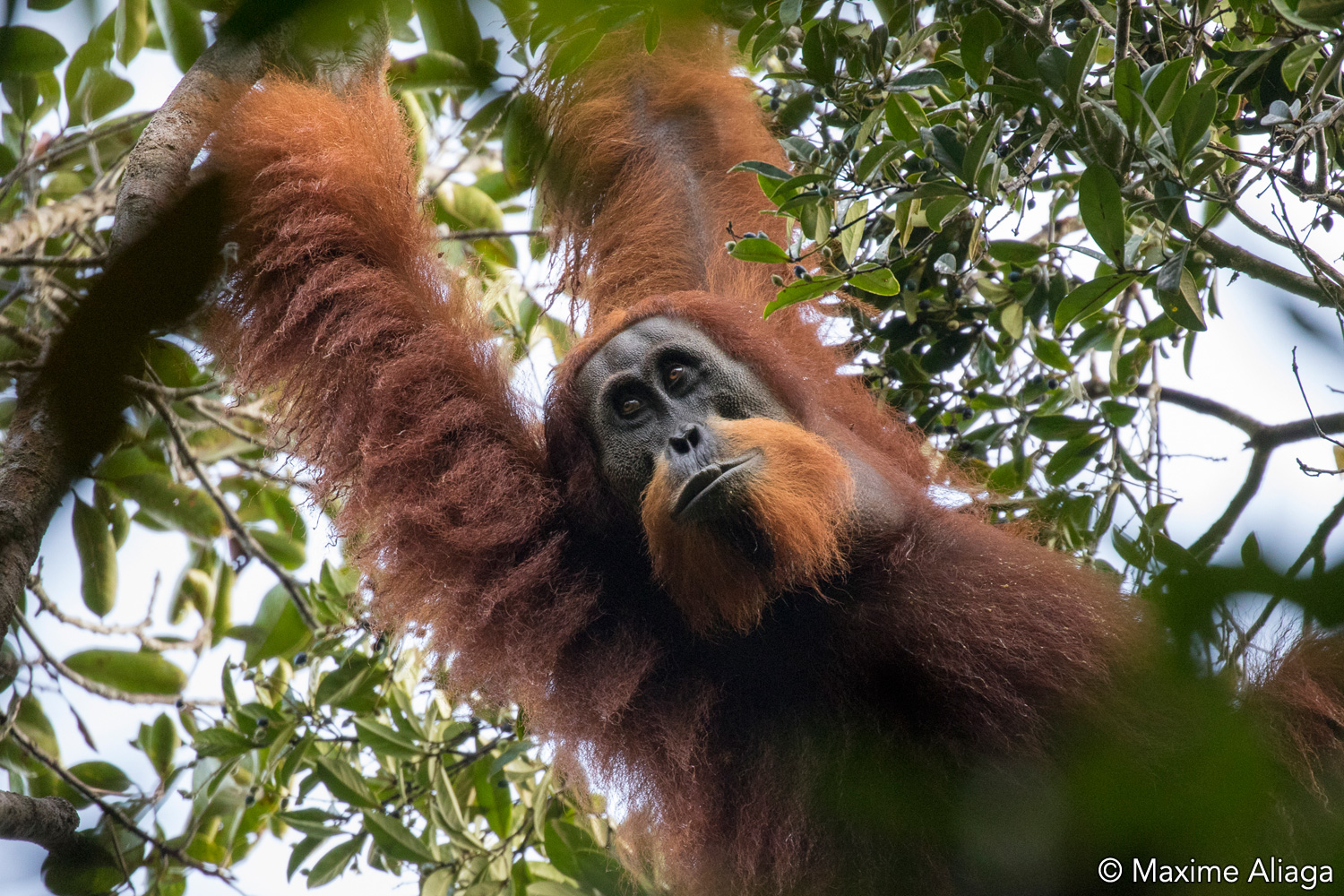- The Indonesian government is drafting another 10-year guideline for orangutan conservation that aims to staunch the decline in the population of the critically endangered great ape.
- This time around, orangutan experts want the federal government to lay out clearer guidelines for conservation roles to be played by local authorities and companies working in orangutan habitats.
- Local authorities and companies are seen as key to protecting the animals’ increasingly fragmented habitat, but tend to favor short-term development and business plans that don’t serve long-term conservation goals.
JAKARTA — Activists in Indonesia are calling for a set of federal guidelines on orangutan conservation that will compel local authorities and companies to take a more active role in protecting the critically endangered great ape.
The call comes in the wake of two violent killings of orangutans in Indonesian Borneo in recent months, and at the end of a 10-year program, launched by the government in 2007, to staunch the decline in the wild orangutan population by protecting their remaining habitats in Sumatra and Borneo.
In the years since that Strategy and Action Plan for National Conservation of Orangutans was launched, however, Indonesia has continued to lose its forests at an alarming rate; in 2012, it surpassed Brazil for the sheer amount of primary forest lost. In 2016, the Bornean orangutan (Pongo pygmaeus) was declared a critically endangered species by the IUCN, or a step away from being extinct in the wild, putting it on par with its Sumatran cousin (Pongo abelii).
While the Indonesian government has not yet published its official evaluation of the 2007-2017 action plan, some conservationists consider it a failure.

As the Indonesian Ministry of Environment and Forestry develops a new action plan for the coming decade, orangutan experts are calling for clearer guidelines for local governments, and for the agribusiness and extractives companies that hold licenses to clear orangutan habitats for plantations and mines.
“The regional governments play the most important role in making and monitoring the implementation of regulations at the grassroots level,” said Arif Rifqi, an orangutan specialist at The Nature Conservancy, an international NGO involved in the creation of both action plans.
The plan, Arif said, must lay out “measurable and realistic” ways to carry out orangutan conservation efforts on the local level.
Erik Meijaard, founder of the environmental advocacy group Borneo Futures, said local governments were crucial for addressing the two key issues in orangutan conservation: forest loss, which calls for better land-use planning and implementation; and hunting, where better policy support, education, media campaigns and law enforcement are needed.
“I hope the next plan will be much more concrete, e.g., achieve zero loss of orangutan habitat by giving all remaining populations protected status and automatically making these forest areas offlimits for development,” Meijaard wrote in an email exchange. “For each forest areas a responsible manager — government, NGO, company, community — needs to be assigned who has the responsibility to ensure the orangutan population remains stable. The government provides funding for this.”
Corruption is one driver of forest loss, as local district chiefs, mayors and governors hand out business permits with impunity, especially during election season.
A lack of interest among local officials in protecting orangutans may also be an issue. The 2007-2017 plan ordered local governments to adopt orangutan conservation policies in their development programs and allocate funding for them. But only a few provinces in Sumatra and in Kalimantan, the Indonesian portion of Borneo, have adopted orangutan conservation schemes into their regional plans, wildlife activists say.
“I seem to recall that some provincial governments enacted gubernatorial policies regarding orangutan conservation,” said Ian Singleton, director of the Sumatran Orangutan Conservation Programme, an NGO, but “even if they did, these things are often done just for good PR and some photo ops in the newspapers with little intent to really implement them, unless somehow they are forced to.”
Singleton, who was involved in the creation of the 2007-2017 plan, said orangutan conservation was typically low on the list of priorities for local governments.

Jamartin Sihite, director of the Bornean Orangutan Survival Foundation (BOSF), echoed Singleton’s sentiments, adding that conservation issues such as orangutan protection were still considered by local governments as being extraneous to development plans.
“The regional governments must start putting environmental costs, including orangutan threats, into the equation when they devise their regional development plans,” Jamartin said. “However, the problem is that local leaders tend to think of short-term wins, and this kind of thinking is an obstacle for conservation.”
With a new round of elections approaching in June this year, Jamartin warned that extra attention should be paid to what local authorities do.
“Every time there’s an election, conservation plans [at the local level] are likely go back to zero,” he said.
The discovery of a new orangutan species endemic to Sumatra has also emphasized the need for guidelines to more clearly designate the conservation roles of local authorities and companies operating in the ape’s habitat. The newly described Tapanuli orangutan (Pongo tapanuliensis) is known to exist only in North Sumatra’s Batang Toru landscape, large swaths of which have already been allocated for development projects and mining sites. The federal and local governments have pledged to try to keep the population safe from extinction.
The bigger picture, though, looks grim. The environment ministry published a study in September last year that confirmed that orangutan numbers were plummeting as their forest habitats continued to be lost to commercial developments. A separate study by researchers from around the world, published in the journal Current Biology in February, calculated that Borneo, which is shared between Indonesia, Malaysia and Brunei, lost nearly 150,000 orangutans between 1999 and 2015, largely as a result of deforestation and killing.
The Indonesian government study put the remaining number of Bornean orangutans in Kalimantan at 57,350 individuals. That translates to a population density of 13 to 47 orangutans per 100 square kilometers, down from around 45 to 76 per square kilometer in 2004.
The study also revealed that nearly four-fifths of wild orangutans in Kalimantan lived outside national parks and other protected areas, leaving them more exposed than ever to threats of deforestation and conflicts with humans.
Hunting remains a key threat to orangutans, which are often considered pests by farmers and plantation workers. A group of rubber farmers was arrested in January and charged with the killing of an orangutan in Central Kalimantan province the previous month. They admitted to shooting the ape more than a dozen times with an air soft gun and decapitating it. Less than a week after the arrest, another orangutan, this time in West Kalimantan, was found shot with a similar weapon more than 100 times. Four pineapple farmers were charged in that incident. Indonesia also made global headlines in 2011 when at least 20 orangutans were slaughtered by plantation workers in East Kalimantan under the guise of “pest control.”

“In the new plan, partnership [to protect orangutans] with the private sector must be strengthened because some of the forested areas allocated for production … are also orangutan habitats,” said Albertus Tjiu, an orangutan researcher with WWF-Indonesia.
Serge Wich, co-vice chair of the section on great apes of the IUCN/SSC Primate Specialist Group and a co-author of the study in Current Biology, said the new action plan must increase the focus on landscape conservation of orangutans in Indonesia, given that the animals now live in fragmented populations that transcend borders.
“Orangutans need to be managed in large areas in which there will be various land uses — protected forest, plantations, ‘other-use’ land, etc.,” Wich said.
“We need to manage orangutans in that matrix and to do that effectively, all parties — governments, local communities, NGOs, companies — need to collaborate in one overall strategy to have an effective spatial plan and have orangutan-friendly management,” he said.
Banner image: An orangutan in a Sumatran forest. Photo by Rhett A. Butler/Mongabay.
FEEDBACK: Use this form to send a message to the author of this post. If you want to post a public comment, you can do that at the bottom of the page.
